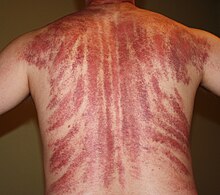This is an old revision of this page, as edited by Harimau777 (talk | contribs) at 13:00, 5 July 2020 (Re-added a section which was previously removed in https://en.wikipedia.org/search/?title=Gua_sha&oldid=876804262). The present address (URL) is a permanent link to this revision, which may differ significantly from the current revision.
Revision as of 13:00, 5 July 2020 by Harimau777 (talk | contribs) (Re-added a section which was previously removed in https://en.wikipedia.org/search/?title=Gua_sha&oldid=876804262)(diff) ← Previous revision | Latest revision (diff) | Newer revision → (diff)| Gua sha | |||||||||||||||||
|---|---|---|---|---|---|---|---|---|---|---|---|---|---|---|---|---|---|
 | |||||||||||||||||
| Chinese | 刮痧 | ||||||||||||||||
| Literal meaning | "scraping sha-bruises" | ||||||||||||||||
| |||||||||||||||||
Gua sha (Chinese: 刮痧), kerokan or coining is part of traditional Chinese medicine (TCM). Its practitioners use a tool to scrape people's skin to cause tissue damage in the belief this has medicinal benefit. Gua sha is sometimes referred to as "scraping", "spooning" or "coining" by English speakers. The treatment has also been called the descriptive French name, tribo-effleurage.
Effectiveness
As reported by a review article in the Journal of the American Academy of Dermatology, the negative side effects of gua sha range from minor ones – including dermatitis, burns and blood in the urine – to rare major ones including bleeding in the brain and severe injuries requiring skin grafts.
Etymology
Gua sha was transferred from China to Vietnam, where it became very popular. It is known as cạo gió, which roughly means "to scrape wind", as in Vietnamese culture "catching a cold" or fever is often referred to as trúng gió, "to catch wind". The origin of this term is the Shang Han Lun, a c. 220 CE Chinese medical text on illness caused by cold. As in most Asian countries, China's medical sciences were a profound influence in Vietnam, especially between the 5th and 7th centuries CE. Cạo gió is an extremely common remedy in Vietnam and for expatriate Vietnamese.
Cross-cultural confusion with physical abuse
A slightly different form of gua sha using the edges of coins rather than porcelain items is practiced as a folk medicine technique. Individuals practice this "coining" amongst their own family members in many Asian countries, such as in Vietnam (where the coin scraping, or "coining" is known as "cạo gió", 'scraping for wind'), or in Cambodia, and also in their respective emigrant communities abroad. Health care practitioners in hospitals in Orange County, California, routinely see evidence of coining among hospitalized Vietnamese patients.
In 1980, it was found that many Vietnamese still distrusted U.S. medical practitioners in part due to fear of being accused of child abuse.
"This practice has been misidentified as child abuse in case reports," despite the intention of the parents. However, physicians are required by law to report injuries from remedies such as "coining" to the appropriate agency (e.g., state child-protective service or state adult-prgraotective service), regardless of intention.
In popular culture
The 2001 movie The Gua Sha Treatment (Chinese: 刮痧; pinyin: guā shā) was made in Hong Kong and showed gua sha. It is a story about cultural conflicts experienced by a Chinese family in the United States.
See also
References
- ^ Vashi NA, Patzelt N, Wirya S, Maymone MB, Zancanaro P, Kundu RV (2018). "Dermatoses caused by cultural practices: Therapeutic cultural practices". J Am Acad Dermatol (Review). 79 (1): 1–16. doi:10.1016/j.jaad.2017.06.159. PMID 29908818.
- Huard & Wong (1977), p.126. Also cited is a French romanization for the same set of two Chinese characters: koua sha.
- Needham, J., Celestial Lancets, Cambridge, UK: Cambridge University.
- "FAQ - Child Abuse - Stanford University School of Medicine". childabuse.stanford.edu.
- Fadem, Barbara (2009). Behavioral Science - Board Review Series. Baltimore, MD: Lippincott Williams & Wilkins. p. 206. ISBN 978-0-7817-8257-9.
- "EFL Movie Study Guide for: The Gua Sha Treatment". Krigline.com. Krigline. Archived from the original on 17 February 2019. Retrieved 17 February 2019.
- "The Treatment: User Reviews". IMDB.com. IMDB. Archived from the original on 17 February 2019. Retrieved 17 February 2019.
